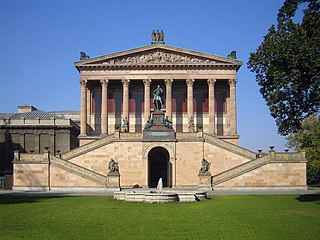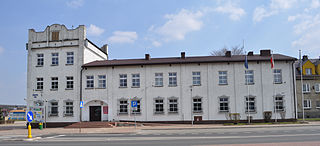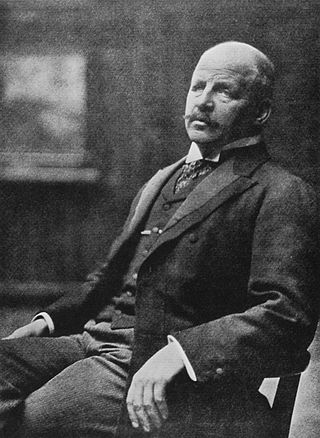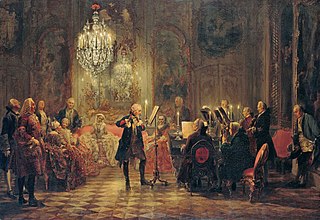
Werner Sombart was a German economist, historian and sociologist. Head of the "Youngest Historical School," he was one of the leading Continental European social scientists during the first quarter of the 20th century. The term late capitalism is accredited to him. The concept of creative destruction associated with capitalism is also of his coinage. His magnum opus was Der moderne Kapitalismus. It was published in three volumes from 1902 through 1927. In Kapitalismus he described four stages in the development of capitalism from its earliest iteration as it evolved out of feudalism, which he called proto-capitalism to early, high and, finally, late capitalism —Spätkapitalismus— in the post World War I period.

Max Liebermann was a German painter and printmaker, and one of the leading proponents of Impressionism in Germany and continental Europe. In addition to his activity as an artist, he also assembled an important collection of French Impressionist works.

Adolph Friedrich Erdmann von Menzel was a German Realist artist noted for drawings, etchings, and paintings. Along with Caspar David Friedrich, he is considered one of the two most prominent German painters of the 19th century, and was the most successful artist of his era in Germany. First known as Adolph Menzel, he was knighted in 1898 and changed his name to Adolph von Menzel.

The Neue Pinakothek is an art museum in Munich, Germany. Its focus is European Art of the 18th and 19th centuries, and it is one of the most important museums of art of the nineteenth century in the world.

The Alte Nationalgalerie is a listed building on the Museum Island in the historic centre of Berlin, Germany. The gallery was built from 1862 to 1876 by the order of King Frederick William IV of Prussia according to plans by Friedrich August Stüler and Johann Heinrich Strack in Neoclassical and Renaissance Revival styles. The building's outside stair features a memorial to Frederick William IV. Currently, the Alte Nationalgalerie is home to paintings and sculptures of the 19th century and hosts a variety of tourist buses daily. As part of the Museum Island complex, the gallery was inscribed on the UNESCO World Heritage List in 1999 for its outstanding architecture and its testimony to the development of museums and galleries as a cultural phenomenon in the late 19th century.

Blachownia is a town in Częstochowa County, Silesian Voivodeship, Poland. It lies about 10 km (6.2 mi) west of the city of Częstochowa. The town belongs to historic Lesser Poland. As of December 2021, it has a population of 9,383.

The Berlin Secession was an art movement established in Germany on May 2, 1898. Formed in reaction to the Association of Berlin Artists, and the restrictions on contemporary art imposed by Kaiser Wilhelm II, 65 artists "seceded," demonstrating against the standards of academic or government-endorsed art. The movement is classified as a form of German Modernism, and came on the heels of several other secessions in Germany, including Jugendstil and the Munich Secession.

The Prussian Academy of Arts was a state arts academy first established in Berlin, Brandenburg, in 1694/1696 by prince-elector Frederick III, in personal union Duke Frederick I of Prussia, and later king in Prussia.

Studio Wall (1872) is an oil painting by the German artist Adolph Menzel, now in the collection of the Hamburger Kunsthalle. It is considered a masterpiece of his maturity, which he deemed his best painting.

Adolf Schrödter or Adolph Schroedter was a German painter and graphic artist; associated with the Düsseldorf school of painting. He is considered to be one of the pioneers of German comics.

The Kronprinzenpalais is a former Royal Prussian residence on Unter den Linden boulevard in the historic centre of Berlin. It was built in 1663 and renovated in 1857 according to plans by Heinrich Strack in Neoclassical style. From 1919 to 1937, it was home to the modern art collection of the National Gallery. Damaged during the Allied bombing in World War II, the Kronprinzenpalais was rebuilt from 1968 to 1970 by Richard Paulick as part of the Forum Fridericianum. In 1990, the German Reunification Treaty was signed in the listed building. Since then, it has been used for events and exhibitions.

Alfred Lichtwark was a German art historian, museum curator, and art educator in Hamburg. He is one of the founders of museum education and the art education movement.

Realism was an artistic movement that emerged in France in the 1840s, around the 1848 Revolution. Realists rejected Romanticism, which had dominated French literature and art since the early 19th century. Realism revolted against the exotic subject matter and the exaggerated emotionalism and drama of the Romantic movement. Instead, it sought to portray real and typical contemporary people and situations with truth and accuracy, and not avoiding unpleasant or sordid aspects of life. The movement aimed to focus on unidealized subjects and events that were previously rejected in art work. Realist works depicted people of all classes in situations that arise in ordinary life, and often reflected the changes brought by the Industrial and Commercial Revolutions. Realism was primarily concerned with how things appeared to the eye, rather than containing ideal representations of the world. The popularity of such "realistic" works grew with the introduction of photography—a new visual source that created a desire for people to produce representations which look objectively real.

The Meeting of Frederick II and Joseph II in Neisse in 1769 is an oil on canvas history painting by Adolph Menzel, executed in 1855–1857, showing the meeting of Frederick II of Prussia with Joseph II, Holy Roman Emperor at Neisse on 25 August 1769. It is now in the Alte Nationalgalerie, in Berlin.

Frederick the Great Playing the Flute at Sanssouci or The Flute Concert is an 1852 oil on canvas history painting by the German painter Adolph Menzel. It depicts Frederick the Great, King of Prussia playing the flute at an evening concert at Sanssouci and is now in the Alte Nationalgalerie in Berlin.

Adolph Kohut was a German-Hungarian journalist, literature and cultural historian, biographer, recitator and translator from Hungarian origin.

Große Berliner Kunstausstellung , abbreviated GroBeKa or GBK, was an annual art exhibition that existed from 1893 to 1969 with intermittent breaks. In 1917 and 1918, during World War I, it was not held in Berlin but in Düsseldorf. In 1919 and 1920, it operated under the name Kunstausstellung Berlin. From 1970 to 1995, the Freie Berliner Kunstausstellung was held annually in its place.

The Balcony Room is an oil-on-canvas painting by the German artist Adolph Menzel, executed in 1845. It is one of the main works of his early period and one of his most famous paintings. It has belonged to the collection of the Alte Nationalgalerie in Berlin, since 1903.

Departure of King Wilhelm I for the Army, July 31, 1870 is an oil on canvas painting by German artist Adolph Menzel, created in 1871. It depicts a scene that takes place in the avenue Unter den Linden, in Berlin, where a crowd is paying tribute to King Wilhelm I of Prussia, as he passes in an open carriage, on his way to the Franco-Prussian War, who had started two weeks earlier. The painting is part of the collection of the Alte Nationalgalerie, in Berlin, since 1881.

The Berlin-Potsdam Railway is an oil-on-canvas painting by German artist Adolph Menzel, created in 1847. It belongs to the early creative phase of the artist and depicts a section of the Berlin-Potsdam Railway, opened in 1838, at the southwest of the city center of Berlin, in a style that seems to anticipate impressionism. This is the first painting to depict a railway train in the landscape in German painting. The work belongs to the collection of the Alte Nationalgalerie, in Berlin, since 1899.




















